User:Dave Keenan/sandbox: Difference between revisions
Dave Keenan (talk | contribs) No edit summary |
Dave Keenan (talk | contribs) No edit summary |
||
| Line 62: | Line 62: | ||
rect 80 0 300 50 [[Sagittal_notation]] | rect 80 0 300 50 [[Sagittal_notation]] | ||
rect 392 0 552 80 [https://sagittal.org#periodic-table Periodic table of EDOs with sagittal notation] | rect 392 0 552 80 [https://sagittal.org#periodic-table Periodic table of EDOs with sagittal notation] | ||
rect 20 80 392 106 [[24-EDO#Sagittal_notation]] | rect 20 80 392 106 [[24-EDO#Sagittal_notation | 24-EDO notation]] | ||
default [[File:8-EDO_Evo_Sagittal.svg]] | default [[File:8-EDO_Evo_Sagittal.svg]] | ||
</imagemap> | </imagemap> | ||
| Line 73: | Line 73: | ||
rect 80 0 300 50 [[Sagittal_notation]] | rect 80 0 300 50 [[Sagittal_notation]] | ||
rect 400 0 560 80 [https://sagittal.org#periodic-table Periodic table of EDOs with sagittal notation] | rect 400 0 560 80 [https://sagittal.org#periodic-table Periodic table of EDOs with sagittal notation] | ||
rect 20 80 400 106 [[24-EDO#Sagittal_notation]] | rect 20 80 400 106 [[24-EDO#Sagittal_notation | 24-EDO notation]] | ||
default [[File:8-EDO_Revo_Sagittal.svg]] | default [[File:8-EDO_Revo_Sagittal.svg]] | ||
</imagemap> | </imagemap> | ||
| Line 84: | Line 84: | ||
rect 80 0 300 50 [[Sagittal_notation]] | rect 80 0 300 50 [[Sagittal_notation]] | ||
rect 376 0 536 80 [https://sagittal.org#periodic-table Periodic table of EDOs with sagittal notation] | rect 376 0 536 80 [https://sagittal.org#periodic-table Periodic table of EDOs with sagittal notation] | ||
rect 20 80 376 106 [[24-EDO#Sagittal_notation]] | rect 20 80 376 106 [[24-EDO#Sagittal_notation | 24-EDO notation]] | ||
default [[File:8-EDO_Evo-SZ_Sagittal.svg]] | default [[File:8-EDO_Evo-SZ_Sagittal.svg]] | ||
</imagemap> | </imagemap> | ||
| Line 91: | Line 91: | ||
===Sagittal notation=== | ===Sagittal notation=== | ||
This notation uses the same sagittal sequence as [[14edo#Sagittal notation|14-EDO | This notation uses the same sagittal sequence as [[14edo#Sagittal notation|14-EDO]]. | ||
<imagemap> | <imagemap> | ||
| Line 104: | Line 104: | ||
===Sagittal notation=== | ===Sagittal notation=== | ||
This notation is a subset of the notations for EDOs [[20edo#Sagittal notation|20]] and [[30edo#Sagittal notation|30]] and a superset of the notation for [[5edo#Sagittal notation|5-EDO | This notation is a subset of the notations for EDOs [[20edo#Sagittal notation|20]] and [[30edo#Sagittal notation|30]] and a superset of the notation for [[5edo#Sagittal notation|5-EDO]]. | ||
<imagemap> | <imagemap> | ||
| Line 137: | Line 137: | ||
rect 80 0 300 50 [[Sagittal_notation]] | rect 80 0 300 50 [[Sagittal_notation]] | ||
rect 400 0 560 80 [https://sagittal.org#periodic-table Periodic table of EDOs with sagittal notation] | rect 400 0 560 80 [https://sagittal.org#periodic-table Periodic table of EDOs with sagittal notation] | ||
rect 20 80 400 106 [[22-EDO#Sagittal_notation]] | rect 20 80 400 106 [[22-EDO#Sagittal_notation | 22-EDO notation]] | ||
default [[File:11-EDO_Evo_Sagittal.svg]] | default [[File:11-EDO_Evo_Sagittal.svg]] | ||
</imagemap> | </imagemap> | ||
| Line 148: | Line 148: | ||
rect 80 0 300 50 [[Sagittal_notation]] | rect 80 0 300 50 [[Sagittal_notation]] | ||
rect 368 0 528 80 [https://sagittal.org#periodic-table Periodic table of EDOs with sagittal notation] | rect 368 0 528 80 [https://sagittal.org#periodic-table Periodic table of EDOs with sagittal notation] | ||
rect 20 80 368 106 [[22-EDO#Sagittal_notation]] | rect 20 80 368 106 [[22-EDO#Sagittal_notation | 22-EDO notation]] | ||
default [[File:11-EDO_Revo_Sagittal.svg]] | default [[File:11-EDO_Revo_Sagittal.svg]] | ||
</imagemap> | </imagemap> | ||
| Line 154: | Line 154: | ||
===Sagittal notation=== | ===Sagittal notation=== | ||
This notation is a subset of the notations for EDOs [[24edo#Sagittal notation|24]], [[36edo#Sagittal notation|36]], [[48edo#Sagittal notation|48]], [[60edo#Sagittal notation|60]], [[72edo#Sagittal notation|72]], and [[84edo#Sagittal notation|84]] and a superset of the notation for [[6edo#Sagittal notation|6-EDO | This notation is a subset of the notations for EDOs [[24edo#Sagittal notation|24]], [[36edo#Sagittal notation|36]], [[48edo#Sagittal notation|48]], [[60edo#Sagittal notation|60]], [[72edo#Sagittal notation|72]], and [[84edo#Sagittal notation|84]] and a superset of the notation for [[6edo#Sagittal notation|6-EDO]]. | ||
====Evo flavor==== | ====Evo flavor==== | ||
| Line 186: | Line 186: | ||
rect 80 0 300 50 [[Sagittal_notation]] | rect 80 0 300 50 [[Sagittal_notation]] | ||
rect 447 0 607 80 [https://sagittal.org#periodic-table Periodic table of EDOs with sagittal notation] | rect 447 0 607 80 [https://sagittal.org#periodic-table Periodic table of EDOs with sagittal notation] | ||
rect 20 80 447 106 [[26-EDO#Sagittal_notation]] | rect 20 80 447 106 [[26-EDO#Sagittal_notation | 26-EDO notation]] | ||
default [[File:13-EDO_Evo_Sagittal.svg]] | default [[File:13-EDO_Evo_Sagittal.svg]] | ||
</imagemap> | </imagemap> | ||
| Line 198: | Line 198: | ||
rect 80 0 300 50 [[Sagittal_notation]] | rect 80 0 300 50 [[Sagittal_notation]] | ||
rect 495 0 655 80 [https://sagittal.org#periodic-table Periodic table of EDOs with sagittal notation] | rect 495 0 655 80 [https://sagittal.org#periodic-table Periodic table of EDOs with sagittal notation] | ||
rect 20 80 495 106 [[26-EDO#Sagittal_notation]] | rect 20 80 495 106 [[26-EDO#Sagittal_notation | 26-EDO notation]] | ||
default [[File:13-EDO_Revo_Sagittal.svg]] | default [[File:13-EDO_Revo_Sagittal.svg]] | ||
</imagemap> | </imagemap> | ||
| Line 204: | Line 204: | ||
===Sagittal notation=== | ===Sagittal notation=== | ||
This notation uses the same sagittal sequence as [[9edo#Sagittal notation|9-EDO#Sagittal_notation]], is a subset of the notations for EDOs [[28edo#Sagittal notation|28]] and [[42edo#Sagittal notation|42b]], and is a superset of the notation for [[7edo#Sagittal notation|7-EDO | This notation uses the same sagittal sequence as [[9edo#Sagittal notation|9-EDO#Sagittal_notation]], is a subset of the notations for EDOs [[28edo#Sagittal notation|28]] and [[42edo#Sagittal notation|42b]], and is a superset of the notation for [[7edo#Sagittal notation|7-EDO]]. | ||
<imagemap> | <imagemap> | ||
| Line 217: | Line 217: | ||
===Sagittal notation=== | ===Sagittal notation=== | ||
This notation uses the same sagittal sequence as EDOs [[22edo#Sagittal notation|22]] and [[29edo#Sagittal notation|29]], is a subset of the notation for [[30edo#Sagittal notation|30-EDO#Sagittal_notation]], and is a superset of the notation for [[5edo#Sagittal notation|5-EDO | This notation uses the same sagittal sequence as EDOs [[22edo#Sagittal notation|22]] and [[29edo#Sagittal notation|29]], is a subset of the notation for [[30edo#Sagittal notation|30-EDO#Sagittal_notation]], and is a superset of the notation for [[5edo#Sagittal notation|5-EDO]]. | ||
<imagemap> | <imagemap> | ||
| Line 230: | Line 230: | ||
===Sagittal notation=== | ===Sagittal notation=== | ||
This notation uses the same sagittal sequence as [[21edo#Sagittal notation|21-EDO | This notation uses the same sagittal sequence as [[21edo#Sagittal notation|21-EDO]]. | ||
<imagemap> | <imagemap> | ||
| Line 243: | Line 243: | ||
===Sagittal notation=== | ===Sagittal notation=== | ||
This notation uses the same sagittal sequence as EDOs [[24edo#Sagittal notation|24]], [[31edo#Sagittal notation|31]], and [[38edo#Sagittal notation|38]], and is a subset of the notation for [[34edo#Sagittal notation|34-EDO | This notation uses the same sagittal sequence as EDOs [[24edo#Sagittal notation|24]], [[31edo#Sagittal notation|31]], and [[38edo#Sagittal notation|38]], and is a subset of the notation for [[34edo#Sagittal notation|34-EDO]]. | ||
<imagemap> | <imagemap> | ||
| Line 279: | Line 279: | ||
===Sagittal notation=== | ===Sagittal notation=== | ||
This notation is a subset of the notations for EDOs [[36edo#Sagittal notation|36]] and [[72edo#Sagittal notation|72]] and a superset of the notation for [[6edo#Sagittal notation|6-EDO | This notation is a subset of the notations for EDOs [[36edo#Sagittal notation|36]] and [[72edo#Sagittal notation|72]] and a superset of the notation for [[6edo#Sagittal notation|6-EDO]]. | ||
====Evo flavor==== | ====Evo flavor==== | ||
| Line 287: | Line 287: | ||
rect 80 0 300 50 [[Sagittal_notation]] | rect 80 0 300 50 [[Sagittal_notation]] | ||
rect 463 0 623 80 [https://sagittal.org#periodic-table Periodic table of EDOs with sagittal notation] | rect 463 0 623 80 [https://sagittal.org#periodic-table Periodic table of EDOs with sagittal notation] | ||
rect 20 80 463 106 [[36-EDO#Sagittal_notation]] | rect 20 80 463 106 [[36-EDO#Sagittal_notation | 36-EDO notation]] | ||
default [[File:18-EDO_Evo_Sagittal.svg]] | default [[File:18-EDO_Evo_Sagittal.svg]] | ||
</imagemap> | </imagemap> | ||
| Line 298: | Line 298: | ||
rect 80 0 300 50 [[Sagittal_notation]] | rect 80 0 300 50 [[Sagittal_notation]] | ||
rect 447 0 607 80 [https://sagittal.org#periodic-table Periodic table of EDOs with sagittal notation] | rect 447 0 607 80 [https://sagittal.org#periodic-table Periodic table of EDOs with sagittal notation] | ||
rect 20 80 447 106 [[36-EDO#Sagittal_notation]] | rect 20 80 447 106 [[36-EDO#Sagittal_notation | 36-EDO notation]] | ||
default [[File:18-EDO_Revo_Sagittal.svg]] | default [[File:18-EDO_Revo_Sagittal.svg]] | ||
</imagemap> | </imagemap> | ||
| Line 352: | Line 352: | ||
===Sagittal notation=== | ===Sagittal notation=== | ||
This notation uses the same sagittal sequence as [[16edo#Sagittal notation|16-EDO#Sagittal_notation]], is a subset of the notation for [[42edo#Sagittal notation|42b]], and is a superset of the notation for [[7edo#Sagittal notation|7-EDO | This notation uses the same sagittal sequence as [[16edo#Sagittal notation|16-EDO#Sagittal_notation]], is a subset of the notation for [[42edo#Sagittal notation|42b]], and is a superset of the notation for [[7edo#Sagittal notation|7-EDO]]. | ||
<imagemap> | <imagemap> | ||
| Line 365: | Line 365: | ||
===Sagittal notation=== | ===Sagittal notation=== | ||
This notation uses the same sagittal sequence as EDOs [[15edo#Sagittal notation|15]] and [[29edo#Sagittal notation|29]], is a subset of the notations for EDOs [[44edo#Sagittal notation|44]] and [[66edo#Sagittal notation|66]], and is a superset of the notation for [[11edo#Sagittal notation|11-EDO | This notation uses the same sagittal sequence as EDOs [[15edo#Sagittal notation|15]] and [[29edo#Sagittal notation|29]], is a subset of the notations for EDOs [[44edo#Sagittal notation|44]] and [[66edo#Sagittal notation|66]], and is a superset of the notation for [[11edo#Sagittal notation|11-EDO]]. | ||
====Evo flavor==== | ====Evo flavor==== | ||
| Line 453: | Line 453: | ||
===Sagittal notation=== | ===Sagittal notation=== | ||
This notation uses the same sagittal sequence as [[32edo#Sagittal notation|32-EDO#Sagittal_notation]], and is a superset of the notation for [[5edo#Sagittal notation|5-EDO | This notation uses the same sagittal sequence as [[32edo#Sagittal notation|32-EDO#Sagittal_notation]], and is a superset of the notation for [[5edo#Sagittal notation|5-EDO]]. | ||
<imagemap> | <imagemap> | ||
| Line 466: | Line 466: | ||
===Sagittal notation=== | ===Sagittal notation=== | ||
This notation is a subset of the notation for [[52edo#Sagittal notation|52-EDO#Sagittal_notation]] and a superset of the notation for [[13edo#Sagittal notation|13-EDO | This notation is a subset of the notation for [[52edo#Sagittal notation|52-EDO#Sagittal_notation]] and a superset of the notation for [[13edo#Sagittal notation|13-EDO]]. | ||
====Evo flavor==== | ====Evo flavor==== | ||
| Line 492: | Line 492: | ||
In the following diagrams, a sagittal symbol followed by an equals sign (=) means that the following comma is the symbol's [[Sagittal notation#Primary comma|primary comma]] (the comma it ''exactly'' represents in JI), while an approximately equals sign (≈) means it is a secondary comma (a comma it ''approximately'' represents in JI). In both cases the symbol exactly represents the tempered version of the comma in this EDO. | In the following diagrams, a sagittal symbol followed by an equals sign (=) means that the following comma is the symbol's [[Sagittal notation#Primary comma|primary comma]] (the comma it ''exactly'' represents in JI), while an approximately equals sign (≈) means it is a secondary comma (a comma it ''approximately'' represents in JI). In both cases the symbol exactly represents the tempered version of the comma in this EDO. | ||
This notation is a subset of the notation for [[54edo#Sagittal notation|54-EDO | This notation is a subset of the notation for [[54edo#Sagittal notation|54-EDO]]. | ||
<imagemap> | <imagemap> | ||
| Line 605: | Line 605: | ||
===Sagittal notation=== | ===Sagittal notation=== | ||
This notation uses the same sagittal sequence as EDOs [[17edo#Sagittal notation|17]], [[24edo#Sagittal notation|24]], and [[38edo#Sagittal notation|38]], and is a subset of the notation for [[62edo#Sagittal notation|62-EDO | This notation uses the same sagittal sequence as EDOs [[17edo#Sagittal notation|17]], [[24edo#Sagittal notation|24]], and [[38edo#Sagittal notation|38]], and is a subset of the notation for [[62edo#Sagittal notation|62-EDO]]. | ||
====Evo flavor==== | ====Evo flavor==== | ||
| Line 680: | Line 680: | ||
===Sagittal notation=== | ===Sagittal notation=== | ||
This notation uses the same sagittal sequence as [[41edo#Sagittal notation|41-EDO#Sagittal_notation]], and is a superset of the notation for [[17edo#Sagittal notation|17-EDO | This notation uses the same sagittal sequence as [[41edo#Sagittal notation|41-EDO#Sagittal_notation]], and is a superset of the notation for [[17edo#Sagittal notation|17-EDO]]. | ||
====Evo flavor==== | ====Evo flavor==== | ||
| Line 717: | Line 717: | ||
===Sagittal notation=== | ===Sagittal notation=== | ||
====Best fifth notation==== | ====Best fifth notation==== | ||
This notation uses the same sagittal sequence as EDOs [[30edo#Sagittal notation|30b]] and [[40edo#Sagittal notation|40]], and is a superset of the notation for [[7edo#Sagittal notation|7-EDO | This notation uses the same sagittal sequence as EDOs [[30edo#Sagittal notation|30b]] and [[40edo#Sagittal notation|40]], and is a superset of the notation for [[7edo#Sagittal notation|7-EDO]]. | ||
<imagemap> | <imagemap> | ||
| Line 729: | Line 729: | ||
====Second best fifth notation==== | ====Second best fifth notation==== | ||
This notation uses the same sagittal sequence as [[42edo#Sagittal notation|42-EDO#Sagittal_notation]], and is a superset of the notation for [[5edo#Sagittal notation|5-EDO | This notation uses the same sagittal sequence as [[42edo#Sagittal notation|42-EDO#Sagittal_notation]], and is a superset of the notation for [[5edo#Sagittal notation|5-EDO]]. | ||
<imagemap> | <imagemap> | ||
| Line 802: | Line 802: | ||
===Sagittal notation=== | ===Sagittal notation=== | ||
This notation uses the same sagittal sequence as EDOs [[17edo#Sagittal notation|17]], [[24edo#Sagittal notation|24]], and [[31edo#Sagittal notation|31]], is a subset of the notation for [[76edo#Sagittal notation|76-EDO#Sagittal_notation]], and is a superset of the notation for [[19edo#Sagittal notation|19-EDO | This notation uses the same sagittal sequence as EDOs [[17edo#Sagittal notation|17]], [[24edo#Sagittal notation|24]], and [[31edo#Sagittal notation|31]], is a subset of the notation for [[76edo#Sagittal notation|76-EDO#Sagittal_notation]], and is a superset of the notation for [[19edo#Sagittal notation|19-EDO]]. | ||
====Evo flavor==== | ====Evo flavor==== | ||
| Line 839: | Line 839: | ||
===Sagittal notation=== | ===Sagittal notation=== | ||
This notation uses the same sagittal sequence as [[46edo#Sagittal notation|46-EDO | This notation uses the same sagittal sequence as [[46edo#Sagittal notation|46-EDO]]. | ||
====Evo flavor==== | ====Evo flavor==== | ||
| Line 877: | Line 877: | ||
===Sagittal notation=== | ===Sagittal notation=== | ||
This notation uses the same sagittal sequence as [[34edo#Sagittal notation|34-EDO | This notation uses the same sagittal sequence as [[34edo#Sagittal notation|34-EDO]]. | ||
====Evo flavor==== | ====Evo flavor==== | ||
| Line 951: | Line 951: | ||
===Sagittal notation=== | ===Sagittal notation=== | ||
This notation uses the same sagittal sequence as [[36edo#Sagittal notation|36-EDO | This notation uses the same sagittal sequence as [[36edo#Sagittal notation|36-EDO]]. | ||
====Evo flavor==== | ====Evo flavor==== | ||
| Line 1,053: | Line 1,053: | ||
===Sagittal notation=== | ===Sagittal notation=== | ||
This notation uses the same sagittal sequence as [[39edo#Sagittal notation|39-EDO | This notation uses the same sagittal sequence as [[39edo#Sagittal notation|39-EDO]]. | ||
====Evo flavor==== | ====Evo flavor==== | ||
| Line 1,312: | Line 1,312: | ||
In the following diagrams, a sagittal symbol followed by an equals sign (=) means that the following comma is the symbol's [[Sagittal notation#Primary comma|primary comma]] (the comma it ''exactly'' represents in JI), while an approximately equals sign (≈) means it is a secondary comma (a comma it ''approximately'' represents in JI). In both cases the symbol exactly represents the tempered version of the comma in this EDO. | In the following diagrams, a sagittal symbol followed by an equals sign (=) means that the following comma is the symbol's [[Sagittal notation#Primary comma|primary comma]] (the comma it ''exactly'' represents in JI), while an approximately equals sign (≈) means it is a secondary comma (a comma it ''approximately'' represents in JI). In both cases the symbol exactly represents the tempered version of the comma in this EDO. | ||
This notation uses the same sagittal sequence as [[61edo#Sagittal notation|61-EDO#Sagittal_notation]], and is a superset of the notation for [[27edo#Sagittal notation|27-EDO | This notation uses the same sagittal sequence as [[61edo#Sagittal notation|61-EDO#Sagittal_notation]], and is a superset of the notation for [[27edo#Sagittal notation|27-EDO]]. | ||
====Evo flavor==== | ====Evo flavor==== | ||
| Line 1,383: | Line 1,383: | ||
===Sagittal notation=== | ===Sagittal notation=== | ||
This notation uses the same sagittal sequence as [[63edo#Sagittal notation|63-EDO | This notation uses the same sagittal sequence as [[63edo#Sagittal notation|63-EDO]]. | ||
====Evo flavor==== | ====Evo flavor==== | ||
| Line 1,410: | Line 1,410: | ||
In the following diagrams, a sagittal symbol followed by an equals sign (=) means that the following comma is the symbol's [[Sagittal notation#Primary comma|primary comma]] (the comma it ''exactly'' represents in JI), while an approximately equals sign (≈) means it is a secondary comma (a comma it ''approximately'' represents in JI). In both cases the symbol exactly represents the tempered version of the comma in this EDO. | In the following diagrams, a sagittal symbol followed by an equals sign (=) means that the following comma is the symbol's [[Sagittal notation#Primary comma|primary comma]] (the comma it ''exactly'' represents in JI), while an approximately equals sign (≈) means it is a secondary comma (a comma it ''approximately'' represents in JI). In both cases the symbol exactly represents the tempered version of the comma in this EDO. | ||
This notation uses the same sagittal sequence as EDOs [[50edo#Sagittal notation|50]], [[64edo#Sagittal notation|64]], and [[71edo#Sagittal notation|71b]], and is a superset of the notation for [[19edo#Sagittal notation|19-EDO | This notation uses the same sagittal sequence as EDOs [[50edo#Sagittal notation|50]], [[64edo#Sagittal notation|64]], and [[71edo#Sagittal notation|71b]], and is a superset of the notation for [[19edo#Sagittal notation|19-EDO]]. | ||
====Evo flavor==== | ====Evo flavor==== | ||
| Line 1,472: | Line 1,472: | ||
In the following diagrams, a sagittal symbol followed by an equals sign (=) means that the following comma is the symbol's [[Sagittal notation#Primary comma|primary comma]] (the comma it ''exactly'' represents in JI), while an approximately equals sign (≈) means it is a secondary comma (a comma it ''approximately'' represents in JI). In both cases the symbol exactly represents the tempered version of the comma in this EDO. | In the following diagrams, a sagittal symbol followed by an equals sign (=) means that the following comma is the symbol's [[Sagittal notation#Primary comma|primary comma]] (the comma it ''exactly'' represents in JI), while an approximately equals sign (≈) means it is a secondary comma (a comma it ''approximately'' represents in JI). In both cases the symbol exactly represents the tempered version of the comma in this EDO. | ||
====Best fifth notation==== | ====Best fifth notation==== | ||
This notation uses the same sagittal sequence as [[66edo#Sagittal notation|66-EDO | This notation uses the same sagittal sequence as [[66edo#Sagittal notation|66-EDO]]. | ||
=====Evo flavor===== | =====Evo flavor===== | ||
| Line 1,560: | Line 1,560: | ||
In the following diagrams, a sagittal symbol followed by an equals sign (=) means that the following comma is the symbol's [[Sagittal notation#Primary comma|primary comma]] (the comma it ''exactly'' represents in JI), while an approximately equals sign (≈) means it is a secondary comma (a comma it ''approximately'' represents in JI). In both cases the symbol exactly represents the tempered version of the comma in this EDO. | In the following diagrams, a sagittal symbol followed by an equals sign (=) means that the following comma is the symbol's [[Sagittal notation#Primary comma|primary comma]] (the comma it ''exactly'' represents in JI), while an approximately equals sign (≈) means it is a secondary comma (a comma it ''approximately'' represents in JI). In both cases the symbol exactly represents the tempered version of the comma in this EDO. | ||
This notation uses the same sagittal sequence as [[54edo#Sagittal notation|54-EDO | This notation uses the same sagittal sequence as [[54edo#Sagittal notation|54-EDO]]. | ||
====Evo flavor==== | ====Evo flavor==== | ||
| Line 1,598: | Line 1,598: | ||
In the following diagrams, a sagittal symbol followed by an equals sign (=) means that the following comma is the symbol's [[Sagittal notation#Primary comma|primary comma]] (the comma it ''exactly'' represents in JI), while an approximately equals sign (≈) means it is a secondary comma (a comma it ''approximately'' represents in JI). In both cases the symbol exactly represents the tempered version of the comma in this EDO. | In the following diagrams, a sagittal symbol followed by an equals sign (=) means that the following comma is the symbol's [[Sagittal notation#Primary comma|primary comma]] (the comma it ''exactly'' represents in JI), while an approximately equals sign (≈) means it is a secondary comma (a comma it ''approximately'' represents in JI). In both cases the symbol exactly represents the tempered version of the comma in this EDO. | ||
This notation uses the same sagittal sequence as EDOs [[69edo#Sagittal notation|69]] and [[76edo#Sagittal notation|76]], and is a superset of the notation for [[31edo#Sagittal notation|31-EDO | This notation uses the same sagittal sequence as EDOs [[69edo#Sagittal notation|69]] and [[76edo#Sagittal notation|76]], and is a superset of the notation for [[31edo#Sagittal notation|31-EDO]]. | ||
====Evo flavor==== | ====Evo flavor==== | ||
| Line 1,634: | Line 1,634: | ||
===Sagittal notation=== | ===Sagittal notation=== | ||
This notation uses the same sagittal sequence as [[56edo#Sagittal notation|56-EDO | This notation uses the same sagittal sequence as [[56edo#Sagittal notation|56-EDO]]. | ||
====Evo flavor==== | ====Evo flavor==== | ||
| Line 1,685: | Line 1,685: | ||
====Second best fifth notation==== | ====Second best fifth notation==== | ||
This notation is a superset of the notation for [[32edo#Sagittal notation|32-EDO | This notation is a superset of the notation for [[32edo#Sagittal notation|32-EDO]]. | ||
=====Evo flavor===== | =====Evo flavor===== | ||
| Line 1,811: | Line 1,811: | ||
In the following diagrams, a sagittal symbol followed by an equals sign (=) means that the following comma is the symbol's [[Sagittal notation#Primary comma|primary comma]] (the comma it ''exactly'' represents in JI), while an approximately equals sign (≈) means it is a secondary comma (a comma it ''approximately'' represents in JI). In both cases the symbol exactly represents the tempered version of the comma in this EDO. | In the following diagrams, a sagittal symbol followed by an equals sign (=) means that the following comma is the symbol's [[Sagittal notation#Primary comma|primary comma]] (the comma it ''exactly'' represents in JI), while an approximately equals sign (≈) means it is a secondary comma (a comma it ''approximately'' represents in JI). In both cases the symbol exactly represents the tempered version of the comma in this EDO. | ||
This notation uses the same sagittal sequence as [[75edo#Sagittal notation|75-EDO | This notation uses the same sagittal sequence as [[75edo#Sagittal notation|75-EDO]]. | ||
====Evo flavor==== | ====Evo flavor==== | ||
| Line 2,010: | Line 2,010: | ||
===Sagittal notation=== | ===Sagittal notation=== | ||
This notation uses the same sagittal sequence as [[80edo#Sagittal notation|80-EDO | This notation uses the same sagittal sequence as [[80edo#Sagittal notation|80-EDO]]. | ||
====Evo flavor==== | ====Evo flavor==== | ||
| Line 2,062: | Line 2,062: | ||
In the following diagrams, a sagittal symbol followed by an equals sign (=) means that the following comma is the symbol's [[Sagittal notation#Primary comma|primary comma]] (the comma it ''exactly'' represents in JI), while an approximately equals sign (≈) means it is a secondary comma (a comma it ''approximately'' represents in JI). In both cases the symbol exactly represents the tempered version of the comma in this EDO. | In the following diagrams, a sagittal symbol followed by an equals sign (=) means that the following comma is the symbol's [[Sagittal notation#Primary comma|primary comma]] (the comma it ''exactly'' represents in JI), while an approximately equals sign (≈) means it is a secondary comma (a comma it ''approximately'' represents in JI). In both cases the symbol exactly represents the tempered version of the comma in this EDO. | ||
This notation uses the same sagittal sequence as [[68edo#Sagittal notation|68-EDO | This notation uses the same sagittal sequence as [[68edo#Sagittal notation|68-EDO]]. | ||
====Evo flavor==== | ====Evo flavor==== | ||
Revision as of 02:24, 16 December 2024
Sagittal notation
This notation is a subset of the notations for EDOs 10, 15, 20, 25, 30, and 35b.
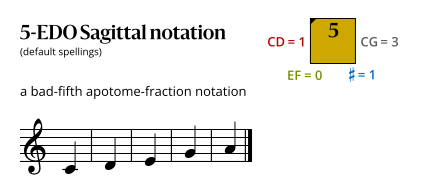
Because it includes no Sagittal symbols, this Sagittal notation is also a conventional notation.
Sagittal notation
This notation is a subset of the notations for EDOs 12, 18, 24, 36, 48, 60, 72, and 84.
Evo flavor

Because it includes no Sagittal symbols, this Evo Sagittal notation is also a conventional notation.
Revo flavor

Sagittal notation
This notation is a subset of the notations for EDOs 14, 21, 28, 35, and 42b.
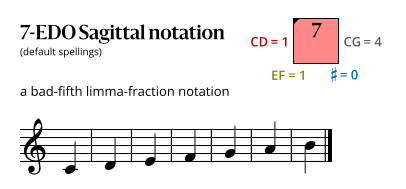
Because it includes no Sagittal symbols, this Sagittal notation is also a conventional notation.
Sagittal notation
This notation is a subset of the notations for EDOs 24, 48, and 72.
Evo flavor

Revo flavor

Evo-SZ flavor

Because it contains no Sagittal symbols, this Evo-SZ Sagittal notation is also a Stein-Zimmerman notation.
Sagittal notation
This notation uses the same sagittal sequence as 14-EDO.
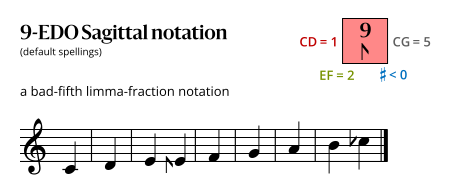
Sagittal notation
This notation is a subset of the notations for EDOs 20 and 30 and a superset of the notation for 5-EDO.
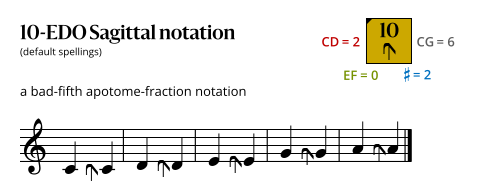
Evo-SZ flavor
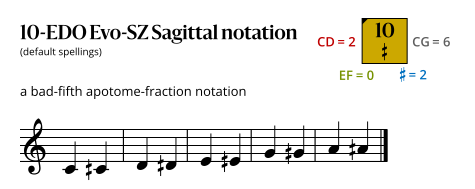
Because it contains no Sagittal symbols, this Evo-SZ Sagittal notation is also a Stein-Zimmerman notation.
Sagittal notation
This notation is a subset of the notations for EDOs 22, 44, and 66.
Evo flavor

Revo flavor

Sagittal notation
This notation is a subset of the notations for EDOs 24, 36, 48, 60, 72, and 84 and a superset of the notation for 6-EDO.
Evo flavor
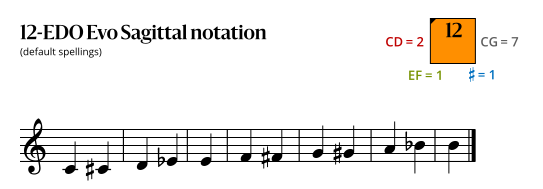
Because it includes no Sagittal symbols, this Evo Sagittal notation is also a conventional notation.
Revo flavor
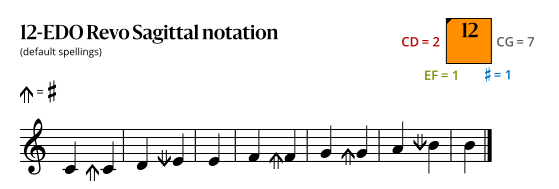
Sagittal notation
This notation is a subset of the notations for EDOs 26 and 52.
Evo flavor

Because it includes no Sagittal symbols, this Evo Sagittal notation is also a conventional notation.
Revo flavor

Sagittal notation
This notation uses the same sagittal sequence as 9-EDO#Sagittal_notation, is a subset of the notations for EDOs 28 and 42b, and is a superset of the notation for 7-EDO.

Sagittal notation
This notation uses the same sagittal sequence as EDOs 22 and 29, is a subset of the notation for 30-EDO#Sagittal_notation, and is a superset of the notation for 5-EDO.

Sagittal notation
This notation uses the same sagittal sequence as 21-EDO.

Sagittal notation
This notation uses the same sagittal sequence as EDOs 24, 31, and 38, and is a subset of the notation for 34-EDO.

Alternate Evo flavor

Evo-SZ flavor

Because it contains no Sagittal symbols, this Evo-SZ Sagittal notation is also a Stein-Zimmerman notation.
Sagittal notation
This notation is a subset of the notations for EDOs 36 and 72 and a superset of the notation for 6-EDO.
Evo flavor

Revo flavor

Sagittal notation
This notation is a subset of the notations for EDOs 38, 57, and 76.
Evo flavor
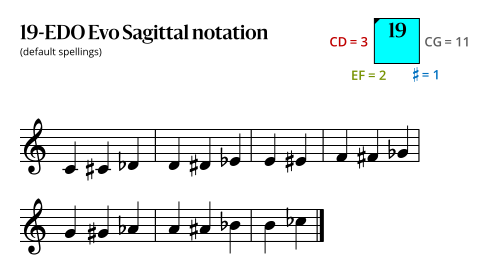
Because it includes no Sagittal symbols, this Evo Sagittal notation is also a conventional notation.
Revo flavor
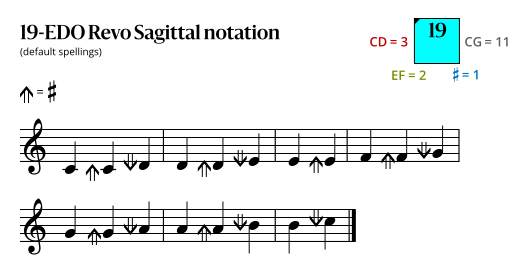
Sagittal notation
This notation is a superset of the notations for EDOs 10 and 5.
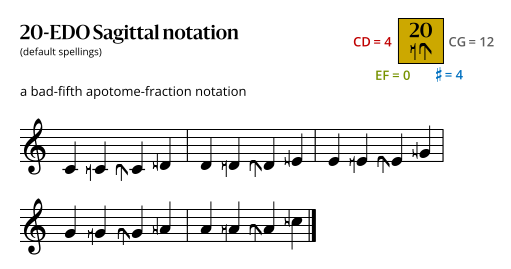
Evo-SZ flavor

Sagittal notation
This notation uses the same sagittal sequence as 16-EDO#Sagittal_notation, is a subset of the notation for 42b, and is a superset of the notation for 7-EDO.
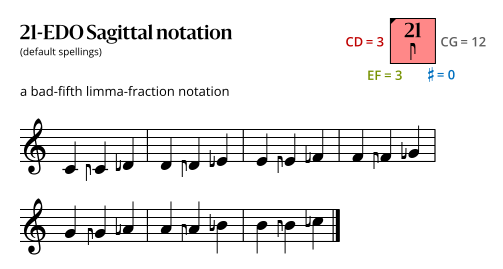
Sagittal notation
This notation uses the same sagittal sequence as EDOs 15 and 29, is a subset of the notations for EDOs 44 and 66, and is a superset of the notation for 11-EDO.
Evo flavor
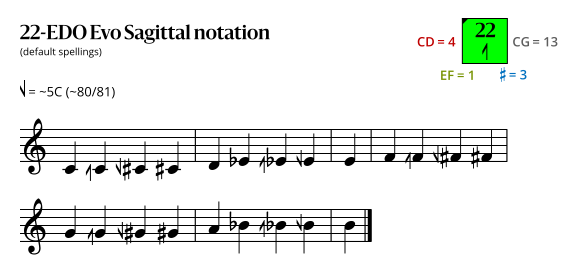
Revo flavor
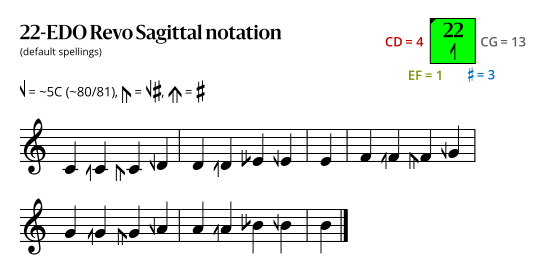
Sagittal notation
Best fifth notation
This notation uses the same sagittal sequence as EDOs 28 and 33.

Second best fifth notation
This notation uses the same sagittal sequence as EDOs 30, 37, and 44.

Sagittal notation
This notation uses the same sagittal sequence as EDOs 17, 31, and 38, is a subset of the notations for EDOs 48 and 72, and is a superset of the notations for EDOs 12, 8, and 6.
Evo flavor
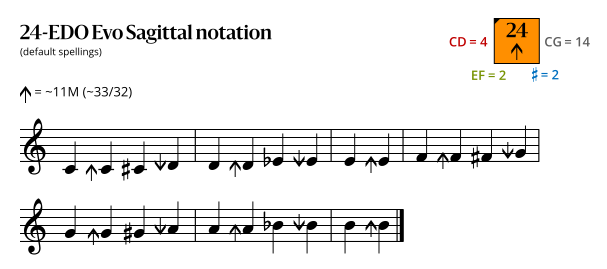
Revo flavor
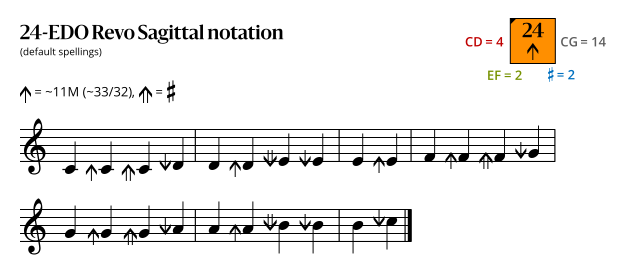
Evo-SZ flavor
Error: No valid link was found at the end of line 6.
Because it contains no Sagittal symbols, this Evo-SZ Sagittal notation is also a Stein-Zimmerman notation.
Sagittal notation
This notation uses the same sagittal sequence as 32-EDO#Sagittal_notation, and is a superset of the notation for 5-EDO.

Sagittal notation
This notation is a subset of the notation for 52-EDO#Sagittal_notation and a superset of the notation for 13-EDO.
Evo flavor
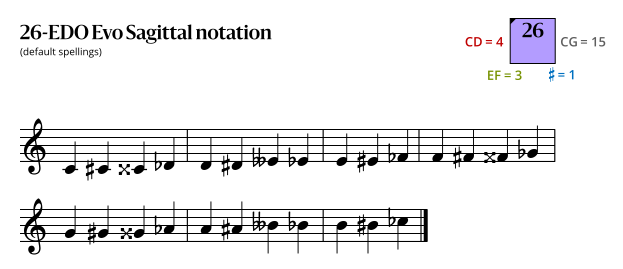
Because it includes no Sagittal symbols, this Evo Sagittal notation is also a conventional notation.
Revo flavor
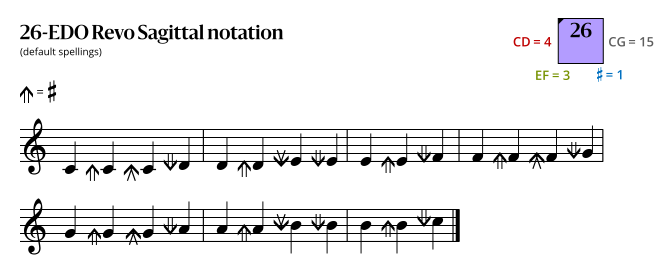
Sagittal notation
In the following diagrams, a sagittal symbol followed by an equals sign (=) means that the following comma is the symbol's primary comma (the comma it exactly represents in JI), while an approximately equals sign (≈) means it is a secondary comma (a comma it approximately represents in JI). In both cases the symbol exactly represents the tempered version of the comma in this EDO.
This notation is a subset of the notation for 54-EDO.
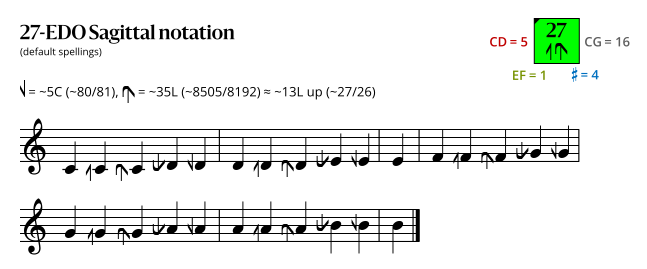
Alternate Evo flavor

Evo-SZ flavor

Sagittal notation
This notation uses the same sagittal sequence as EDOs 23 and 33, and is a superset of the notations for EDOs 14 and 7.
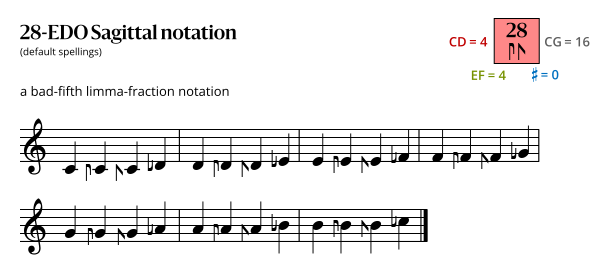
Sagittal notation
This notation uses the same sagittal sequence as EDOs 15 and 22.
Evo flavor

Revo flavor

Sagittal notation
Best fifth notation
This notation uses the same sagittal sequence as EDOs 23b, 37, and 44, and is a superset of the notations for EDOs 15, 10, and 5.

Evo-SZ flavor

Second best fifth notation
This notation uses the same sagittal sequence as EDOs 35 and 40.
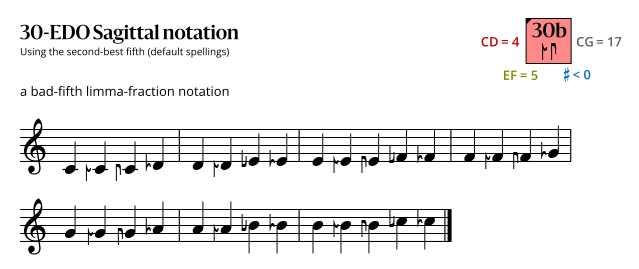
Sagittal notation
This notation uses the same sagittal sequence as EDOs 17, 24, and 38, and is a subset of the notation for 62-EDO.
Evo flavor

Revo flavor
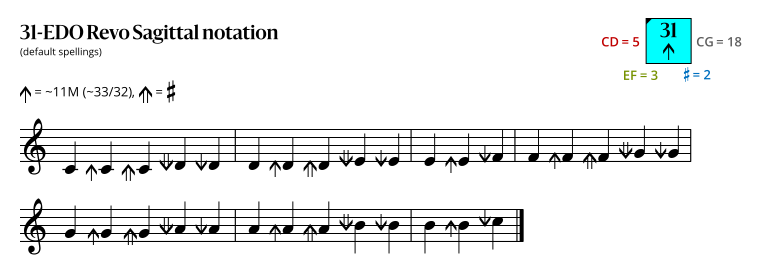
Evo-SZ flavor
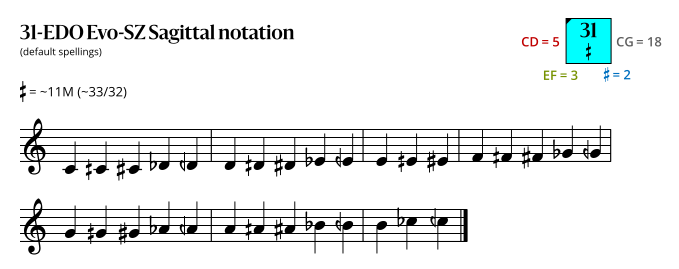
Because it contains no Sagittal symbols, this Evo-SZ Sagittal notation is also a Stein-Zimmerman notation.
Sagittal notation
This notation uses the same sagittal sequence as 25-EDO#Sagittal_notation, and is a subset of the notation for 64b.
Evo flavor

Revo flavor

Sagittal notation
This notation uses the same sagittal sequence as EDOs 23 and 28.

Sagittal notation
This notation uses the same sagittal sequence as 41-EDO#Sagittal_notation, and is a superset of the notation for 17-EDO.
Evo flavor

Revo flavor

Evo-SZ flavor

Sagittal notation
Best fifth notation
This notation uses the same sagittal sequence as EDOs 30b and 40, and is a superset of the notation for 7-EDO.

Second best fifth notation
This notation uses the same sagittal sequence as 42-EDO#Sagittal_notation, and is a superset of the notation for 5-EDO.

Sagittal notation
This notation uses the same sagittal sequence as 43-EDO#Sagittal_notation, is a subset of the notation for 72-EDO#Sagittal_notation, and is a superset of the notations for EDOs 18, 12, and 6.
Evo flavor

Revo flavor

Sagittal notation
This notation uses the same sagittal sequence as EDOs 23b, 30, and 44.

Alternate Evo flavor

Evo-SZ flavor

Sagittal notation
This notation uses the same sagittal sequence as EDOs 17, 24, and 31, is a subset of the notation for 76-EDO#Sagittal_notation, and is a superset of the notation for 19-EDO.
Evo flavor

Revo flavor

Evo-SZ flavor

Because it contains no Sagittal symbols, this Evo-SZ Sagittal notation is also a Stein-Zimmerman notation.
Sagittal notation
This notation uses the same sagittal sequence as 46-EDO.
Evo flavor

Revo flavor

Sagittal notation
This notation uses the same sagittal sequence as EDOs 30b and 35.

Sagittal notation
This notation uses the same sagittal sequence as 34-EDO.
Evo flavor

Revo flavor

Evo-SZ flavor

Sagittal notation
Best fifth notation
This notation uses the same sagittal sequence as 35b.
Evo flavor

Revo flavor

Second best fifth notation
This notation uses the same sagittal sequence as 47-EDO#Sagittal_notation, and is a superset of the notations for EDOs 21, 14, and 7.

Sagittal notation
This notation uses the same sagittal sequence as 36-EDO.
Evo flavor

Revo flavor

Sagittal notation
In the following diagrams, a sagittal symbol followed by an equals sign (=) means that the following comma is the symbol's primary comma (the comma it exactly represents in JI), while an approximately equals sign (≈) means it is a secondary comma (a comma it approximately represents in JI). In both cases the symbol exactly represents the tempered version of the comma in this EDO.
This notation uses the same sagittal sequence as EDOs 23b, 30, and 37, and is a superset of the notations for EDOs 22 and 11.
Evo flavor

Revo flavor

Evo-SZ flavor

Sagittal notation
In the following diagrams, a sagittal symbol followed by an equals sign (=) means that the following comma is the symbol's primary comma (the comma it exactly represents in JI), while an approximately equals sign (≈) means it is a secondary comma (a comma it approximately represents in JI). In both cases the symbol exactly represents the tempered version of the comma in this EDO.
This notation uses the same sagittal sequence as EDOs 52 and 59b.
Evo flavor
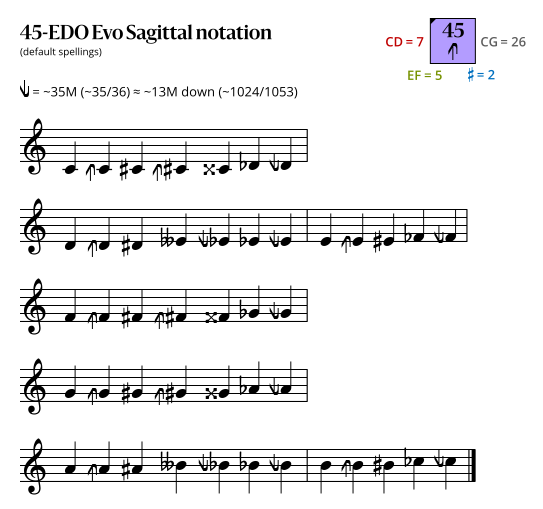
Revo flavor
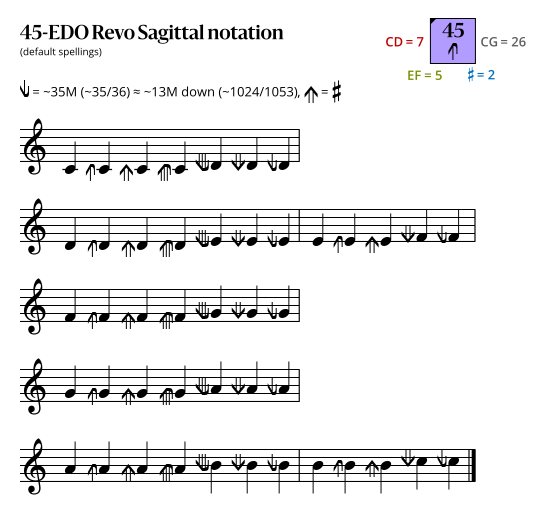
Evo-SZ flavor

Because it contains no Sagittal symbols, this Evo-SZ Sagittal notation is also a Stein-Zimmerman notation.
Sagittal notation
This notation uses the same sagittal sequence as 39-EDO.
Evo flavor
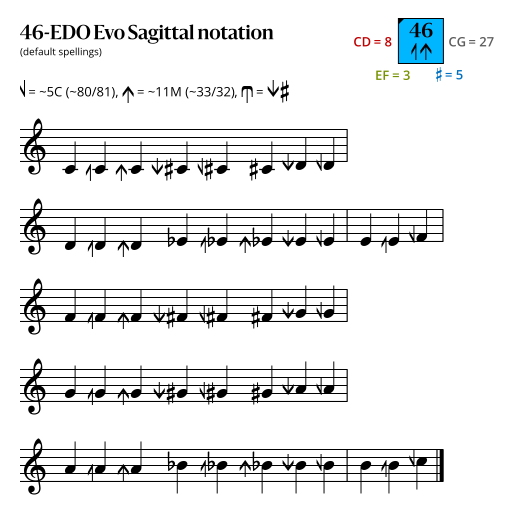
Revo flavor

Sagittal notation
Best fifth notation
This notation uses the same sagittal sequence as 42b.
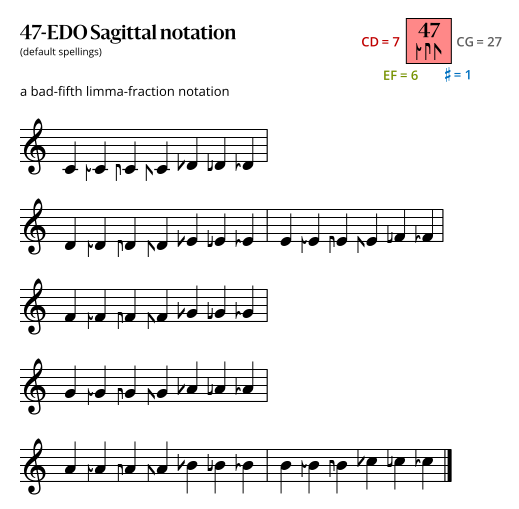
Second best fifth notation

Alternate Evo flavor
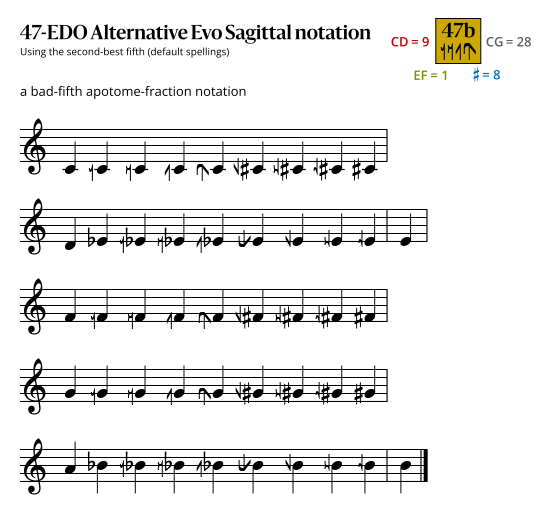
Evo-SZ flavor

Sagittal notation
This notation is a superset of the notations for EDOs 24, 12, 8, and 6.
Evo flavor

Revo flavor
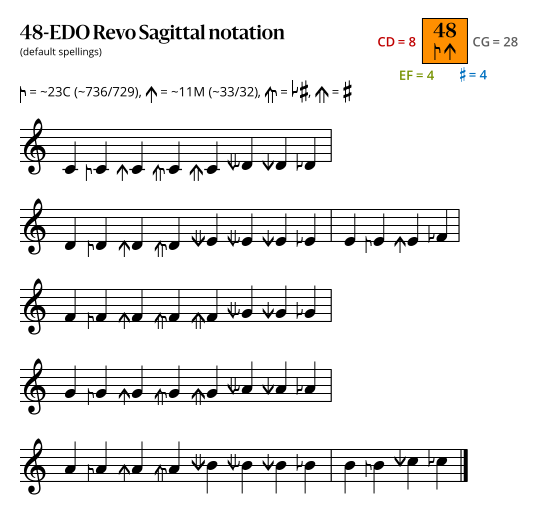
Evo-SZ flavor
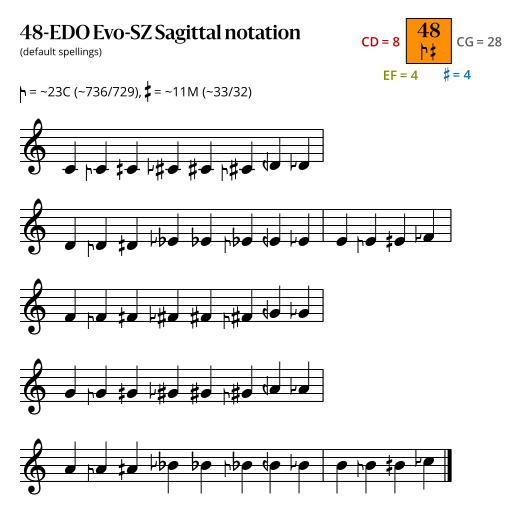
Sagittal notation
Evo flavor

Revo flavor
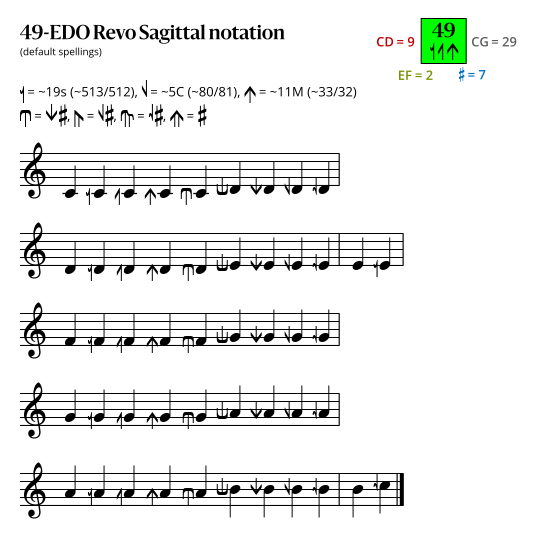
Sagittal notation
In the following diagrams, a sagittal symbol followed by an equals sign (=) means that the following comma is the symbol's primary comma (the comma it exactly represents in JI), while an approximately equals sign (≈) means it is a secondary comma (a comma it approximately represents in JI). In both cases the symbol exactly represents the tempered version of the comma in this EDO.
This notation uses the same sagittal sequence as EDOs 57, 64, and 71b.
Evo flavor

Revo flavor

Sagittal notation
In the following diagrams, a sagittal symbol followed by an equals sign (=) means that the following comma is the symbol's primary comma (the comma it exactly represents in JI), while an approximately equals sign (≈) means it is a secondary comma (a comma it approximately represents in JI). In both cases the symbol exactly represents the tempered version of the comma in this EDO.
Evo flavor

Revo flavor
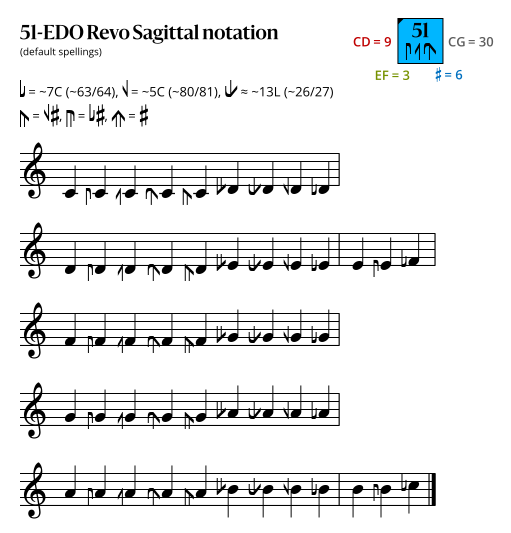
Evo-SZ flavor
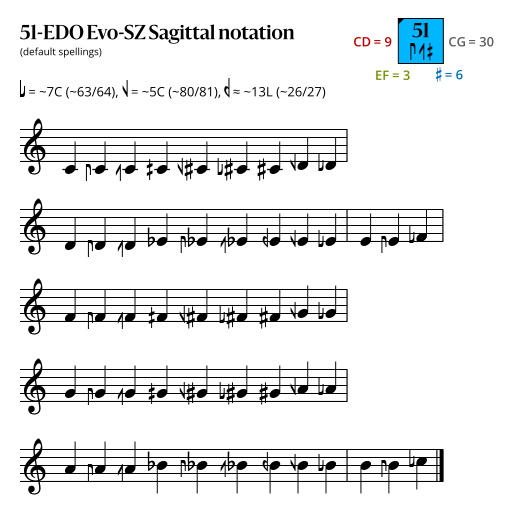
Sagittal notation
This notation uses the same sagittal sequence as EDOs 45 and 59b, and is a superset of the notations for EDOs 26 and 13.
Evo flavor
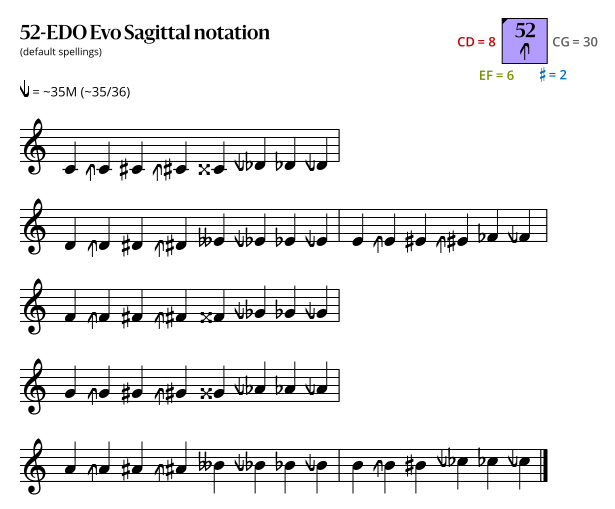
Revo flavor
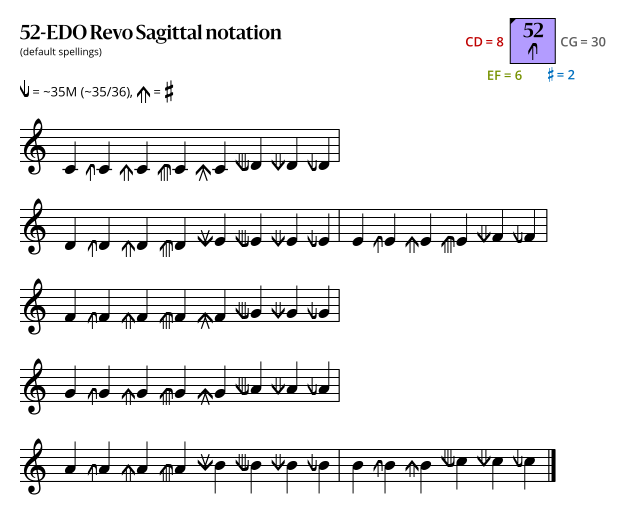
Evo-SZ flavor
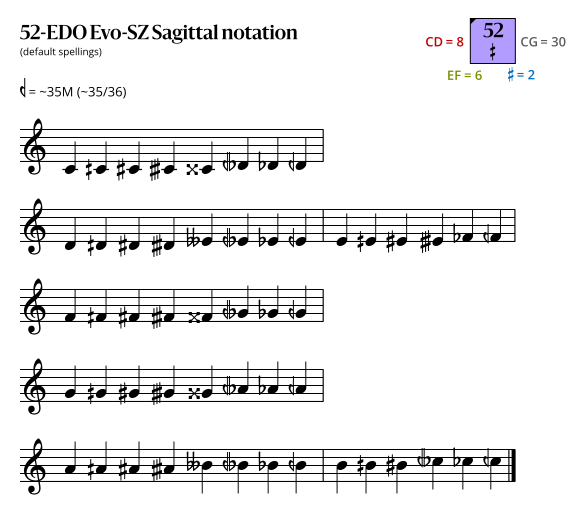
Because it contains no Sagittal symbols, this Evo-SZ Sagittal notation is also a Stein-Zimmerman notation.
Sagittal notation
In the following diagrams, a sagittal symbol followed by an equals sign (=) means that the following comma is the symbol's primary comma (the comma it exactly represents in JI), while an approximately equals sign (≈) means it is a secondary comma (a comma it approximately represents in JI). In both cases the symbol exactly represents the tempered version of the comma in this EDO.
Evo flavor
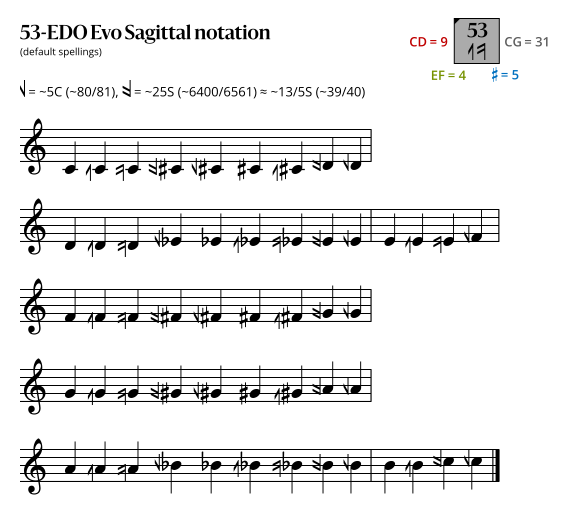
Revo flavor

Sagittal notation
In the following diagrams, a sagittal symbol followed by an equals sign (=) means that the following comma is the symbol's primary comma (the comma it exactly represents in JI), while an approximately equals sign (≈) means it is a secondary comma (a comma it approximately represents in JI). In both cases the symbol exactly represents the tempered version of the comma in this EDO.
This notation uses the same sagittal sequence as 61-EDO#Sagittal_notation, and is a superset of the notation for 27-EDO.
Evo flavor

Revo flavor

Evo-SZ flavor

Sagittal notation
Evo flavor
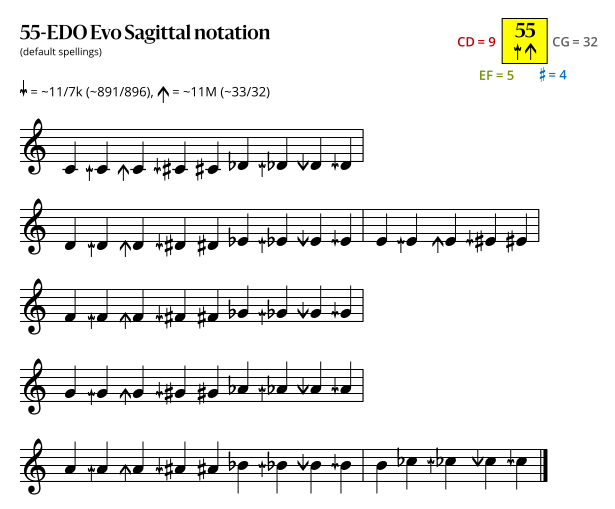
Revo flavor
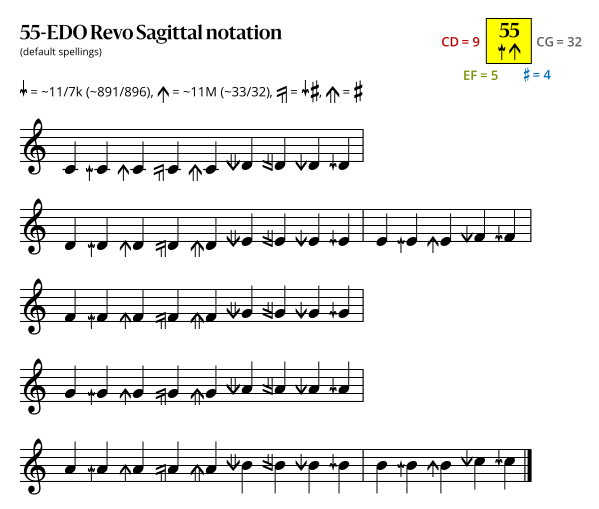
Evo-SZ flavor

Sagittal notation
This notation uses the same sagittal sequence as 63-EDO.
Evo flavor
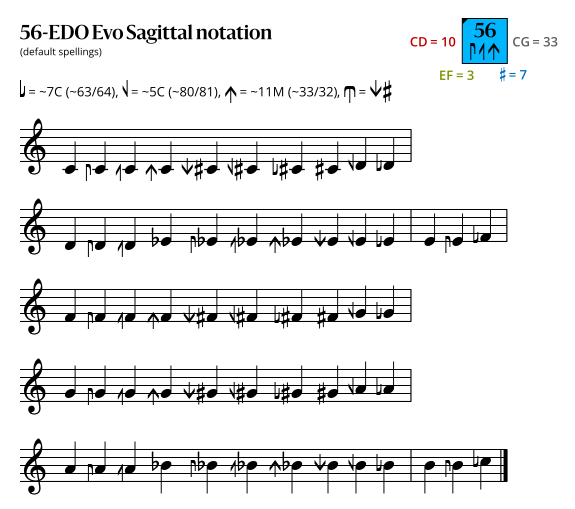
Revo flavor
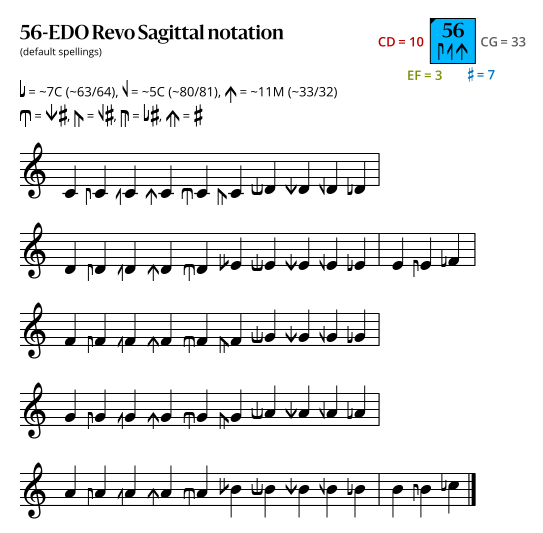
Sagittal notation
In the following diagrams, a sagittal symbol followed by an equals sign (=) means that the following comma is the symbol's primary comma (the comma it exactly represents in JI), while an approximately equals sign (≈) means it is a secondary comma (a comma it approximately represents in JI). In both cases the symbol exactly represents the tempered version of the comma in this EDO.
This notation uses the same sagittal sequence as EDOs 50, 64, and 71b, and is a superset of the notation for 19-EDO.
Evo flavor

Revo flavor

Sagittal notation
Evo flavor
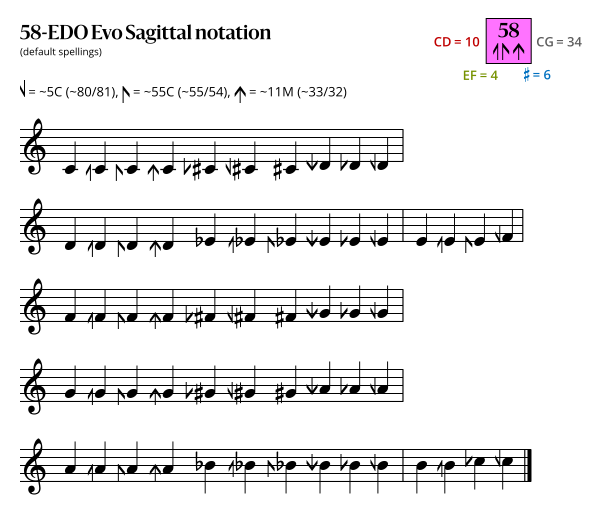
Revo flavor

Evo-SZ flavor

Sagittal notation
In the following diagrams, a sagittal symbol followed by an equals sign (=) means that the following comma is the symbol's primary comma (the comma it exactly represents in JI), while an approximately equals sign (≈) means it is a secondary comma (a comma it approximately represents in JI). In both cases the symbol exactly represents the tempered version of the comma in this EDO.
Best fifth notation
This notation uses the same sagittal sequence as 66-EDO.
Evo flavor

Revo flavor

Second best fifth notation
This notation uses the same sagittal sequence as EDOs 45 and 52.
Evo flavor

Revo flavor

Evo-SZ flavor

Because it contains no Sagittal symbols, this Evo-SZ Sagittal notation is also a Stein-Zimmerman notation.
Sagittal notation
This notation is a superset of the notations for EDOs 12 and 6.
Evo flavor

Revo flavor

Sagittal notation
In the following diagrams, a sagittal symbol followed by an equals sign (=) means that the following comma is the symbol's primary comma (the comma it exactly represents in JI), while an approximately equals sign (≈) means it is a secondary comma (a comma it approximately represents in JI). In both cases the symbol exactly represents the tempered version of the comma in this EDO.
This notation uses the same sagittal sequence as 54-EDO.
Evo flavor

Revo flavor

Evo-SZ flavor

Sagittal notation
In the following diagrams, a sagittal symbol followed by an equals sign (=) means that the following comma is the symbol's primary comma (the comma it exactly represents in JI), while an approximately equals sign (≈) means it is a secondary comma (a comma it approximately represents in JI). In both cases the symbol exactly represents the tempered version of the comma in this EDO.
This notation uses the same sagittal sequence as EDOs 69 and 76, and is a superset of the notation for 31-EDO.
Evo flavor

Revo flavor

Evo-SZ flavor

Sagittal notation
This notation uses the same sagittal sequence as 56-EDO.
Evo flavor
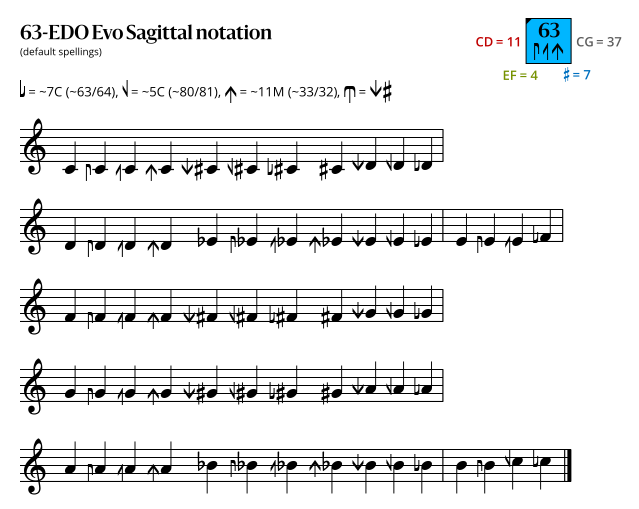
Revo flavor

Sagittal notation
In the following diagrams, a sagittal symbol followed by an equals sign (=) means that the following comma is the symbol's primary comma (the comma it exactly represents in JI), while an approximately equals sign (≈) means it is a secondary comma (a comma it approximately represents in JI). In both cases the symbol exactly represents the tempered version of the comma in this EDO.
Best fifth notation
This notation uses the same sagittal sequence as EDOs 50, 57, and 71b.
Evo flavor

Revo flavor

Second best fifth notation
This notation is a superset of the notation for 32-EDO.
Evo flavor

Revo flavor
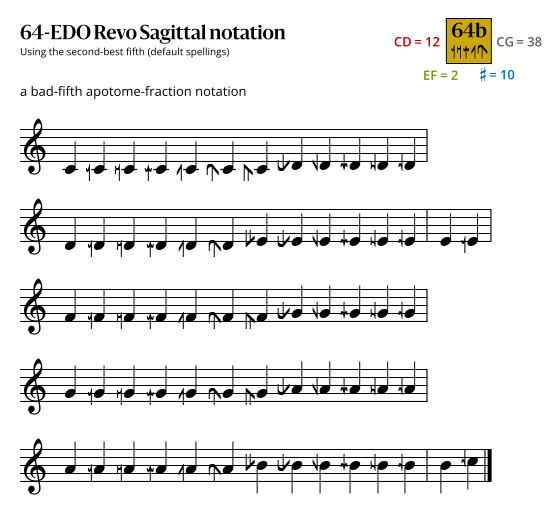
Evo-SZ flavor

Sagittal notation
This notation uses the same sagittal sequence as EDOs 72 and 79.
Evo flavor

Revo flavor

Evo-SZ flavor

Sagittal notation
In the following diagrams, a sagittal symbol followed by an equals sign (=) means that the following comma is the symbol's primary comma (the comma it exactly represents in JI), while an approximately equals sign (≈) means it is a secondary comma (a comma it approximately represents in JI). In both cases the symbol exactly represents the tempered version of the comma in this EDO.
This notation uses the same sagittal sequence as 59-EDO#Sagittal_notation, and is a superset of the notations for EDOs 22 and 11.
Evo flavor

Revo flavor

Sagittal notation
In the following diagrams, a sagittal symbol followed by an equals sign (=) means that the following comma is the symbol's primary comma (the comma it exactly represents in JI), while an approximately equals sign (≈) means it is a secondary comma (a comma it approximately represents in JI). In both cases the symbol exactly represents the tempered version of the comma in this EDO.
Evo flavor

Revo flavor

Sagittal notation
In the following diagrams, a sagittal symbol followed by an equals sign (=) means that the following comma is the symbol's primary comma (the comma it exactly represents in JI), while an approximately equals sign (≈) means it is a secondary comma (a comma it approximately represents in JI). In both cases the symbol exactly represents the tempered version of the comma in this EDO.
This notation uses the same sagittal sequence as 75-EDO.
Evo flavor

Revo flavor

Evo-SZ flavor

Sagittal notation
In the following diagrams, a sagittal symbol followed by an equals sign (=) means that the following comma is the symbol's primary comma (the comma it exactly represents in JI), while an approximately equals sign (≈) means it is a secondary comma (a comma it approximately represents in JI). In both cases the symbol exactly represents the tempered version of the comma in this EDO.
This notation uses the same sagittal sequence as EDOs 62 and 76.
Evo flavor

Revo flavor

Evo-SZ flavor

Sagittal notation
Evo flavor

Revo flavor

Sagittal notation
In the following diagrams, a sagittal symbol followed by an equals sign (=) means that the following comma is the symbol's primary comma (the comma it exactly represents in JI), while an approximately equals sign (≈) means it is a secondary comma (a comma it approximately represents in JI). In both cases the symbol exactly represents the tempered version of the comma in this EDO.
Best fifth notation
Evo flavor

Revo flavor

Evo-SZ flavor

Second best fifth notation
This notation uses the same sagittal sequence as EDOs 50, 57, and 64.
Evo flavor

Revo flavor

Sagittal notation
This notation uses the same sagittal sequence as EDOs 65 and 79, and is a superset of the notations for EDOs 36, 24, 18, 12, 8, and 6.
Evo flavor

Revo flavor

Evo-SZ flavor

Sagittal notation
This notation uses the same sagittal sequence as 80-EDO.
Evo flavor

Revo flavor

Sagittal notation
In the following diagrams, a sagittal symbol followed by an equals sign (=) means that the following comma is the symbol's primary comma (the comma it exactly represents in JI), while an approximately equals sign (≈) means it is a secondary comma (a comma it approximately represents in JI). In both cases the symbol exactly represents the tempered version of the comma in this EDO.
Evo flavor

Revo flavor

Sagittal notation
In the following diagrams, a sagittal symbol followed by an equals sign (=) means that the following comma is the symbol's primary comma (the comma it exactly represents in JI), while an approximately equals sign (≈) means it is a secondary comma (a comma it approximately represents in JI). In both cases the symbol exactly represents the tempered version of the comma in this EDO.
This notation uses the same sagittal sequence as 68-EDO.
Evo flavor

Revo flavor

Evo-SZ flavor

Sagittal notation
In the following diagrams, a sagittal symbol followed by an equals sign (=) means that the following comma is the symbol's primary comma (the comma it exactly represents in JI), while an approximately equals sign (≈) means it is a secondary comma (a comma it approximately represents in JI). In both cases the symbol exactly represents the tempered version of the comma in this EDO.
This notation uses the same sagittal sequence as EDOs 62 and 69, and is a superset of the notations for EDOs 38 and 19.
Evo flavor

Revo flavor

Evo-SZ flavor

Sagittal notation
Evo flavor

Revo flavor
